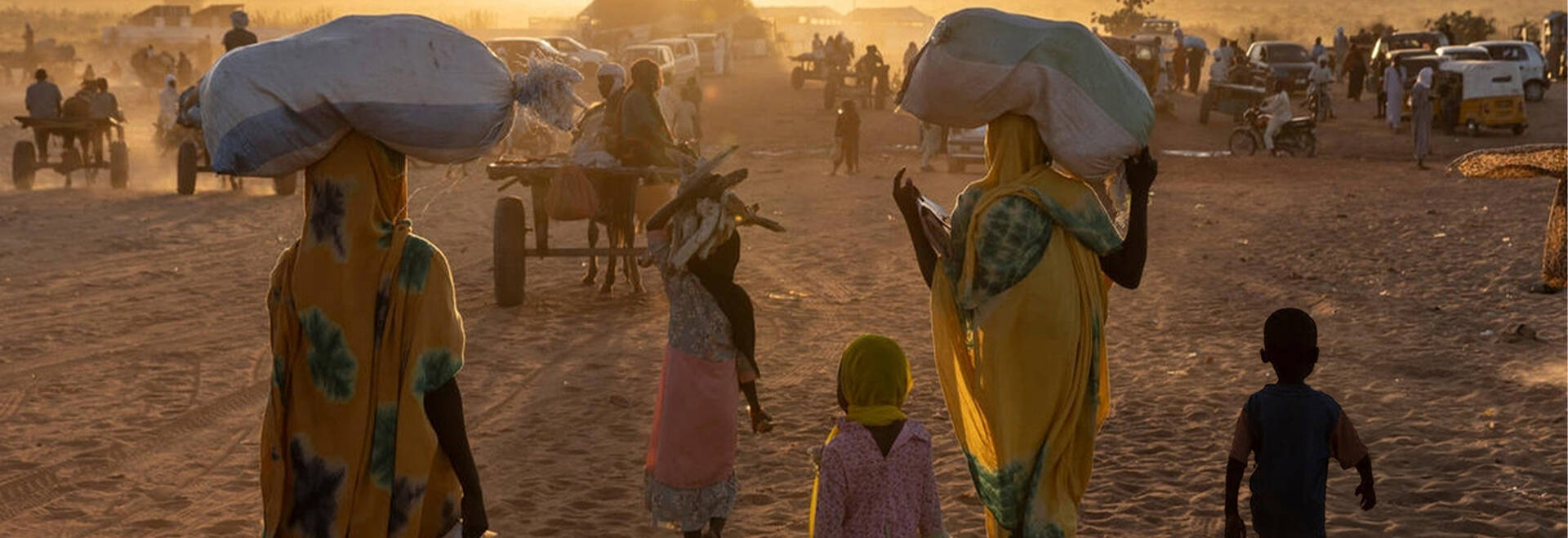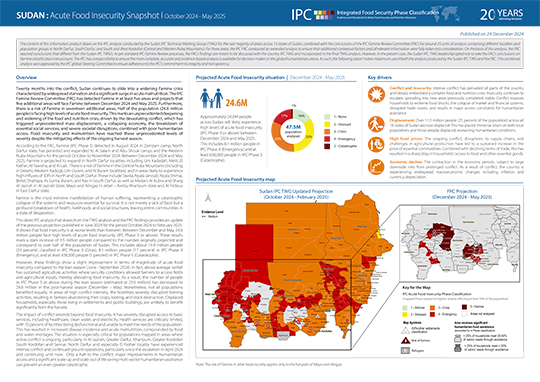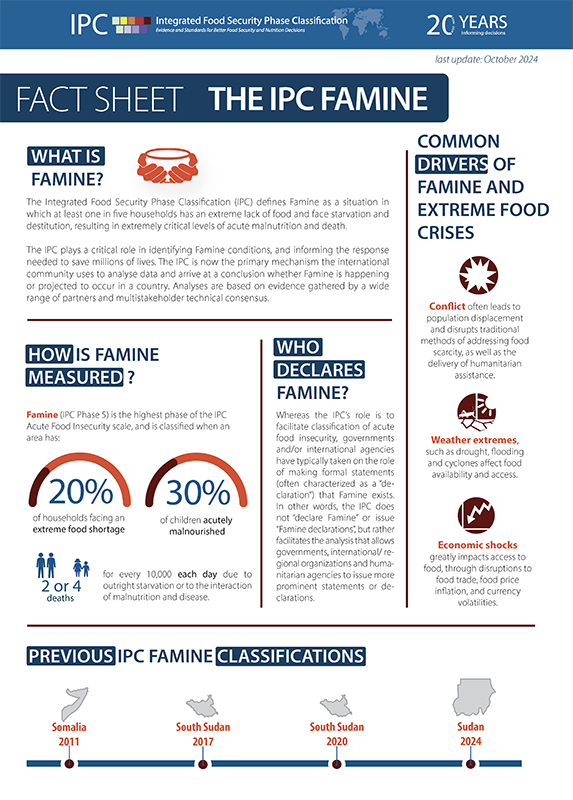
- © UNHCR
SUDAN: Famine expands as conflict drives catastrophic hunger to more areas
Snapshot
Twenty months into the conflict, Sudan continues to slide into a widening Famine crisis characterized by widespread starvation and a significant surge in acute malnutrition. The IPC Famine Review Committee (FRC) has detected Famine in at least five areas and projects that five additional areas will face Famine between December 2024 and May 2025. Furthermore, there is a risk of Famine in seventeen additional areas. Half of the population (24.6 million people) is facing high levels of acute food insecurity. This marks an unprecedented deepening and widening of the food and nutrition crisis, driven by the devastating conflict, which has triggered unprecedented mass displacement, a collapsing economy, the breakdown of essential social services, and severe societal disruptions, and poor humanitarian access.
According to the FRC, Famine (IPC Phase 5) detected in August 2024 in Zamzam camp, North Darfur state, has persisted and expanded to Al Salam and Abu shouk camps and the Western Nuba Mountains for the period October to November 2024. Between December 2024 and May 2025, Famine is projected to expand in North Darfur localities including Um Kadadah, Melit, El Fasher, At Tawisha, and Al Lait. There is a risk of Famine in the Central Nuba Mountains (including in Delami, Western Kadugli, Um Durein, and Al Buram localities), and in areas likely to experience high influxes of IDPs in North and South Darfur. These include Tawila, Nyala Janoub, Nyala Shimal, Beliel, Shattaya, As Sunta, Buram, and Kas in South Darfur, as well as Medani Al Kubra and Sharg Al Jazirah in Al Jazirah State, Mayo and Alingaz in Jebel – Awilia, Khartoum state and Al Firdous in East Darfur state.
This latest IPC analysis that draws from the TWG analysis and the FRC findings provides an update of the previous projection published in June 2024 for the period October 2024 to February 2025. It shows that food insecurity is at worse levels than foreseen. Between December and May, 24.6 million people face high levels of acute food insecurity (IPC Phase 3 or above). These results mark a stark increase of 3.5 million people compared to the number originally projected and correspond to over half of the population of Sudan. This includes about 15.9 million people (33 percent) classified in IPC Phase 3 (Crisis), 8.1 million people (17 percent) in IPC Phase 4 (Emergency), and at least 638,000 people (1 percent) in IPC Phase 5 (Catastrophe).
However, these findings show a slight improvement in terms of magnitude of acute food insecurity compared to the lean season (June - September 2024). In fact, above average rainfall has sustained agriculture activities where security conditions allowed farmers to access fields and agricultural inputs, thereby alleviating food insecurity. As a result, the number of people in IPC Phase 3 or above during the lean season (estimated at 25.6 million) has decreased to 24.6 million in the harvest season (December – May). Nonetheless, not all populations benefited equally. In areas of high conflict intensity, the hostilities severely disrupted farming activities, resulting in farmers abandoning their crops, looting, and stock destruction. Displaced households, especially those living in settlements and public buildings, are unlikely to benefit significantly from the harvest.
Download the Snapshot
FRC Report
In the period October to November 2024, the FRC classified in Famine (IPC Phase 5) at least five areas for which reliable data exists: Zamzam, Abu Shouk and Al Salam camps in North Darfur and both residents and IDPs in the Western Nuba mountains. This is considering that acute malnutrition and mortality are expected to continue meeting or surpassing the threshold for IPC Phase 5 (Famine), taking into account the convergence of contributing factors for acute food insecurity. In the Western Nuba Mountains, the Food Consumption Score and the Household Hunger Score (from data collected in August) suggest a prevalence of population in IPC Phase 5 (Catastrophe) at or above 20 percent. Global Acute Malnutrition prevalence was already over the IPC Phase 5 threshold in August. It is unlikely that seasonal mitigating factors have led to a drastic improvement.
In the period December 2024 to May 2025, the FRC projects that Famine (IPC Phase 5) will persist in Zamzam, Abu Shouk and Al Salam camps and the Western Nuba mountains; and will expand to five additional localities in North Darfur: Um Kadadah, Melit, El Fasher, At Tawisha, Al Lait.
There is a risk of Famine in seventeen additional areas, including in the Central Nuba Mountains (including in Delami, Western Kadugli, Um Durein, and Al Buram localities), and in areas likely to experience high influxes of IDPs in North and South Darfur. These include Tawila, Nyala Janoub, Nyala Shimal, Beliel, Shattaya, As Sunta, Buram, and Kas in South Darfur, as well as Medani Al Kubra and Sharg Al Jazirah in Al Jazirah State, Mayo and Alingaz in Jebel – Awilia, Khartoum state and Al Firdous in East Darfur state.
Download the FRC Report
Learn more about the Famine Review Committee
IPC FAMINE FACT SHEET: Learn more about the IPC Famine Classification
The Integrated Food Security Phase Classification (IPC) defines Famine as an extreme deprivation of food. Starvation, death, destitution and extremely critical levels of acute malnutrition are or will likely be evident.
The IPC plays a critical role in identifying Famine conditions, and informing the response needed to save millions of lives. The IPC is now the primary mechanism the international community uses to analyse data and arrive at a conclusion whether Famine is happening or likely happening in a country. Analyses are based on evidence gathered by a wide range of partners and multistakeholder technical consensus.
Download IPC Famine Factsheet
Join our mailing list



